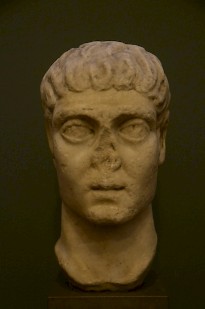Zosimus, New History 2
Zosimus (Greek Ζώσιμος): Early Byzantine, pagan author of a history of the Roman Empire, published in the first quarter of the sixth century CE.
Book 2

The first part of the second book is lost. The surviving part begins with a digression on the Secular Games, which Zosimus must have inserted after his account of the resignation of Diocletian and Maximian. After this, Constantine became sole ruler, and with him, the rise of Christianity began. Zosimus says:
When Constantine and Licinius were in their third consulship, ... the festival ought to have been kept according to custom; but it was neglected, and affairs consequently declined to their present unfortunate condition.note
The reign of Constantine is the subject of 2.8-28: after the death of his father, he is made emperor by his soldiers, defeats his rivals Maxentius and Licinius, and is responsible for several important measures and innovations. However, the successful emperor is forced to execute his son Crispus and his wife Fausta, after which he feels extremely guilty and becomes a Christian. He builds Constantinople and reorganizes the Roman Empire. Zosimus is not too happy with these measures:
To speak in plain terms, Constantine was the first cause of the affairs of the Empire declining to their present miserable state.note
The final chapters of the second book deal with Constantine’s sons. Constantius II is responsible for the execution of a great many relatives and wages war against Magnentius (for which Zosimus is our main source). The book ends with a lengthy account of Constantius' campaign against Magnentius and the latter's defeat in the battle of Mursa, and a summary of the career of the caesar Gallus.
Zosimus’ main source in this book is the Universal History by Eunapius. There may be a second source, however, perhaps an epic poem, about the war against Magnentius, but it is not clear whether it is Zosimus or Eunapius who summarizes it.
Contents
- Mythological origin of the Tarentum
- Mythological origin of the Tarentum
- Valerius Publicola
- Historical Celebrations of the Secular Games
- Procedure of the Secular Games
- An Oracle about the Secular Games
- Importance of the Secular Games
- The Second Tetrarchy
- Rise of Constantine and Maxentius
- Crisis in the Second Tetrarchy
- Death of Galerius; fall of Maximian
- Revolt of Alexander
- Fire in Rome
- Downfall of Alexander
- War between Maxentius and Constantine
- Battle of the Milvian Bridge
- Rejoicing in Rome
- War between Constantine and Licinius
- Constantine defeats Licinius
- Peace between Constantine and Licinius
- Constantine's Sarmatian war
- Second war between Constantine and Licinius
- Constantine besieges Byzantium
- Naval operations
- Licinius retreats from Byzantium
- Byzantium surrenders to Constantine
- Hormisdas
- Death of Licinius
- Conversion of Constantine
- Foundation of Constantinople
- Constantinople
- Changes to the praetorian prefecture
- Four prefectures
- A new strategy
- Constantinople is too big
- An oracle about Constantinople
- Text of this oracle
- Constantine's taxes
- Death of Constantine
- Purges
- Dispute between Constantine II and Constans
- Coup of Magnentius; death of Constans
- Revolt of Nepotianus
- The end of Vetranio
- Constantius advances against Magnentius
- Philip's embassy to Magnentius
- Speech of Magnentius
- Constantius proceeds to Cibalis
- Magnentius proceeds to Mursa
- Skirmishes near Mursa
- Battle of Mursa
- Heroic behavior of Menelaus
- End of Magnentius
- Retrospect on Magnentius' reign
- Fall of Gallus